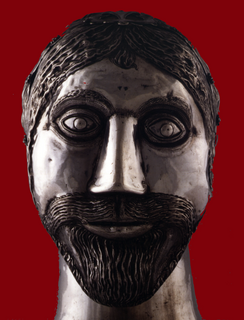
Pope Fabian was the bishop of Rome from 10 January 236 to his death on 20 January 250, succeeding Anterus. A dove is said to have descended on his head to mark him as the Holy Spirit's unexpected choice to become the next pope. He was succeeded by Cornelius.
Pope Caius, also called Gaius, was the bishop of Rome from 17 December 283 to his death in 296. Little information on Caius is available except that given by the Liber Pontificalis, which relies on a legendary account of the martyrdom of Susanna of Rome for its information. According to legend, Caius baptized the men and women who had been converted by Tiburtius and Castulus. His legend states that Caius took refuge in the catacombs of Rome and died a martyr.

Clotilde, also known as Clothilde, Clotilda, Clotild, Rotilde etc., was a Queen of All the Franks. She was supposedly descended from the Gothic king Athanaric and became the second wife of the Frankish king Clovis I in 493. The Merovingian dynasty to which her husband belonged ruled Frankish kingdoms for over 200 years (450–758).

Catherine of Alexandria, or Katherine of Alexandria, also known as Saint Catherine of Alexandria, Saint Catherine of the Wheel and The Great Martyr Saint Catherine, is, according to tradition, a Christian saint and virgin, who was martyred in the early 4th century at the hands of the emperor Maxentius. According to her hagiography, she was both a princess and a noted scholar who became a Christian around the age of 14, converted hundreds of people to Christianity and was martyred around the age of 18. More than 1,100 years after Catherine's martyrdom, Joan of Arc identified her as one of the saints who appeared to and counselled her.

The Catacombs of Rome are ancient catacombs, underground burial places in and around Rome, of which there are at least forty, some rediscovered only in recent decades. Though most famous for Christian burials, either in separate catacombs or mixed together, Jews and also adherents of a variety of pagan Roman religions were buried in catacombs, beginning in the 2nd century AD, occasioned by the ancient Roman ban on burials within a city, and also as a response to overcrowding and shortage of land. The most extensive and perhaps the best known is the Christian Catacomb of Callixtus located near the Park of the Caffarella, but there are other sites, both Christian and not, scattered around the city, some of which are now engulfed in the modern urban sprawl.

Saint Sebastian was an early Christian saint and martyr. According to traditional belief, he was killed during the Diocletianic Persecution of Christians. He was initially tied to a post or tree and shot with arrows, though this did not kill him. He was, according to tradition, rescued and healed by Saint Irene of Rome, which became a popular subject in 17th-century painting. In all versions of the story, shortly after his recovery he went to Diocletian to warn him about his sins, and as a result was clubbed to death. He is venerated in the Roman Catholic Church and the Orthodox Church.

Christianization was the conversion of societies to Christianity beginning in late antiquity in the Roman Empire and continuing through the Late Middle Ages in Europe. Outside of ancient Europe, the process was significantly reversed in the Levant by the Sunni Caliphate, with parallel process of Islamisation, beginning in pre-Islamic Arabia and the Near East.

Georges de La Tour was a French Baroque painter, who spent most of his working life in the Duchy of Lorraine, which was temporarily absorbed into France between 1641 and 1648. He painted mostly religious chiaroscuro scenes lit by candlelight.

Saint NinoEqual to the Apostles and the Enlightener of Georgia was a woman who preached Christianity in the territory of Caucasian Iberia, of what is now part of Georgia. It resulted in the Christianization of the royal house of Iberia, with the consequent Christianization of Iberia.
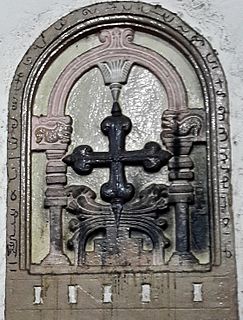
The Synod of Diamper , held at Udayamperoor in June 1599, was a diocesan synod, or council, that created rules and regulations for the ancient Saint Thomas Christians of the Malabar Coast, a part of modern-day Kerala state, India, formally subjugating them and downgrading their whole Metropolitanate of India as the diocese of Angamale, a suffragan see to the Archdiocese of Goa administered by Roman Catholic Padroado missionaries. This synod also introduced many Latin practices in the liturgy of the Saint Thomas Christians which they had been following from centuries. The forced Latinization and disregard for the eastern and local tradition led to a massive protest by Saint Thomas Christians known as Coonan Cross Oath and subsequent schism among them the by mid-17th century.

The designation Four Crowned Martyrs or Four Holy Crowned Ones refers to nine individuals venerated as martyrs and saints in Early Christianity. The nine saints are divided into two groups:
- Severus, Severian(us), Carpophorus (Carpoforus), Victorinus
- Claudius, Castorius, Symphorian (Simpronian), Nicostratus, and Simplicius
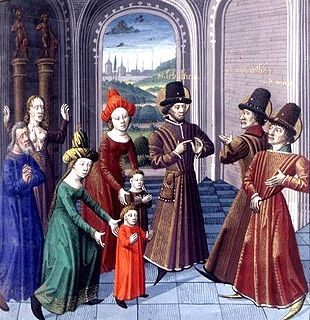
Mark and Marcellian are martyrs venerated as saints by the Roman Catholic Church and the Eastern Orthodox Church. Their cult is sometimes associated with that of Saints Tranquillinus, Martia, Nicostratus, Zoe, Castulus and Tiburtius, though not in the official liturgical books of the Church, which mention only Mark and Marcellianus among the saints for 18 June. Their mention in the General Roman Calendar on that date from before the time of the Tridentine Calendar was removed in the 1969 revision, because nothing is known about them except their names, the fact of their martyrdom, and that they were buried on 18 June in the cemetery of Santa Balbina on the Via Ardeatina.

San Sebastiano al Palatino is a church on the northeastern corner of the Palatine Hill in Rome. It is dedicated to Saint Sebastian, a late-third-century Christian martyr under the reign of Diocletian. According to legend, the church was built on the site of the saint's "first" martyrdom with arrows, which was unsuccessful.
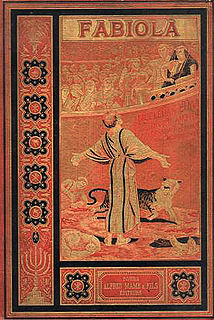
Fabiola or, the Church of the Catacombs is a novel by the English Cardinal Nicholas Wiseman. It was first published in 1854. The novel has been adapted to film three times.
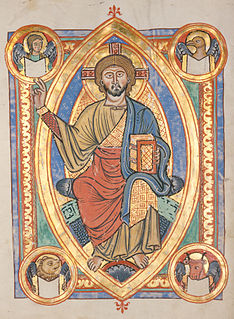
The Roman Catholic tradition includes a number of devotions to Jesus Christ. Like all Catholic devotions, these prayer forms are not part of the official public liturgy of the Church but are based on the popular spiritual practices of Roman Catholics. Many are officially approved by the Holy See as suitable for spiritual growth but not necessary for salvation.

Trophime Bigot (1579–1650), also known as Théophile Bigot, Teofili Trufemondi, the Candlelight Master, was a French painter of the Baroque era, active in Rome and his native Provence.

The Church of the East, also called the Persian Church or the Nestorian Church, was an Eastern Christian church of the East Syriac Rite, based in Mesopotamia. It was one of three major branches of Eastern Christianity that arose from the Christological controversies of the 5th and 6th centuries, alongside the Oriental Orthodox Churches and the Chalcedonian Church. During the early modern period, a series of schisms gave rise to rival patriarchates, sometimes two, sometimes three. Since the latter half of the 20th century, three churches in Iraq claim the heritage of the Church of the East. Meanwhile, the East Syriac churches in India claim the heritage of the Church of the East in India.
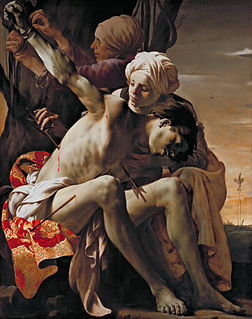
Saint Sebastian Tended by Irene is an oil-on-canvas painting by Hendrick ter Brugghen dated to 1625. Now in the Allen Memorial Art Museum of Oberlin, Ohio, the piece depicts the Roman Catholic subject of Saint Sebastian Tended by Saint Irene, after Irene of Rome and her maid rescued him following his attempted martyrdom by the Roman authorities. An exemplary piece of the Italianate Baroque tendency in Dutch Golden Age painting, the painting employs dramatic uses of light and skillful chiaroscuro to depict its religious subject, evidence of influence from Caravaggio and Ter Brugghen's fellow Utrecht Caravaggisti.
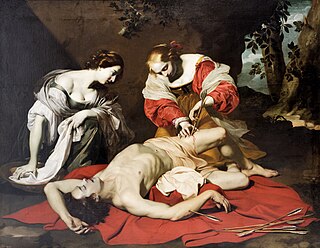
Saint Sebastian Tended by Saint Irene is an incident in the legends of Saint Sebastian and Saint Irene of Rome. It was not prominent in the hagiographical literature until the late Renaissance, and is hardly seen in art before then. As an artistic subject, normally in painting, it suddenly became popular from the 1610s, though found in predella scenes as early as the 15th century, and was most popular until about the 1670s.

























